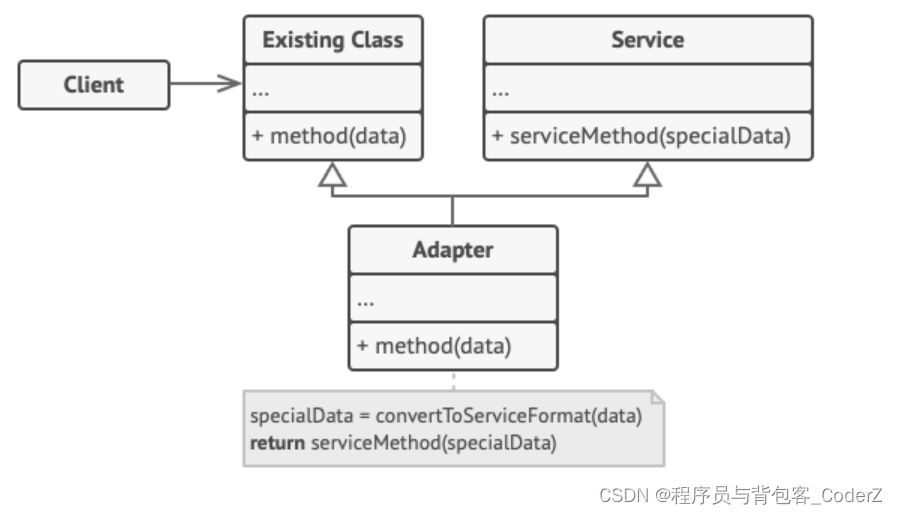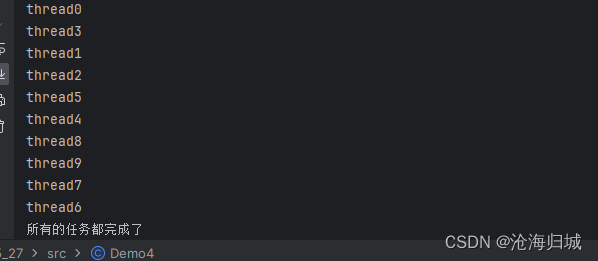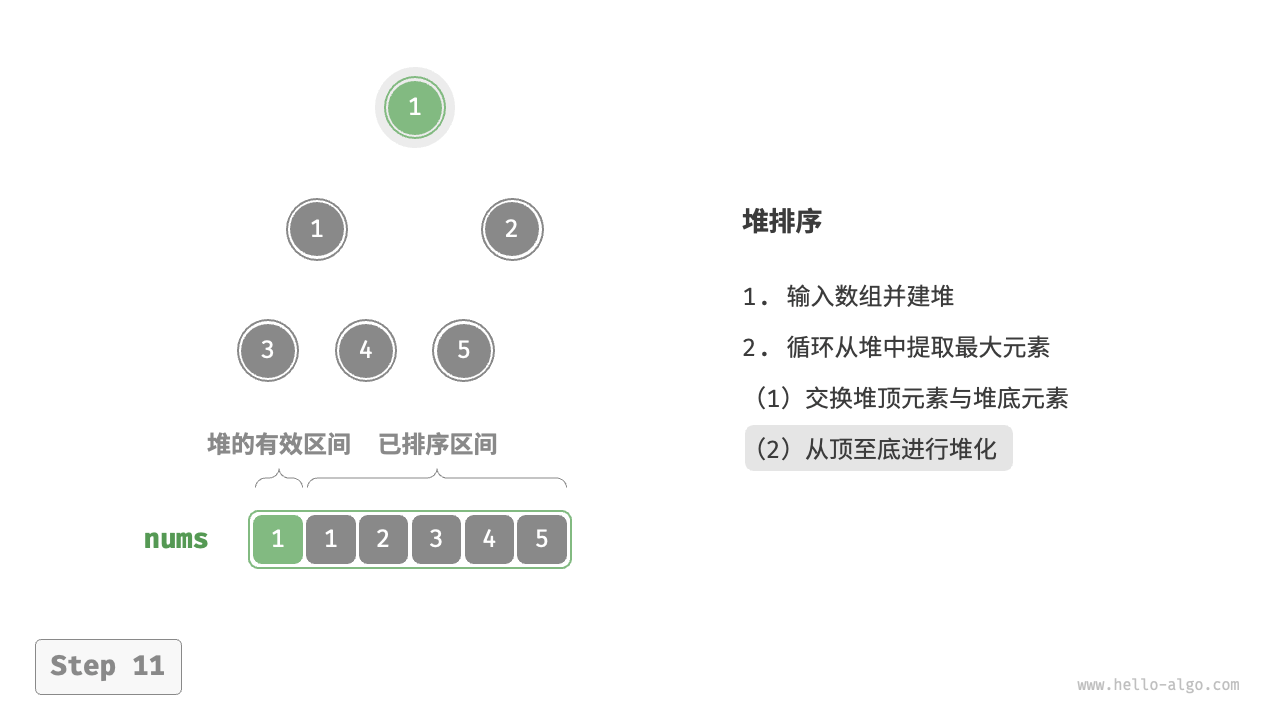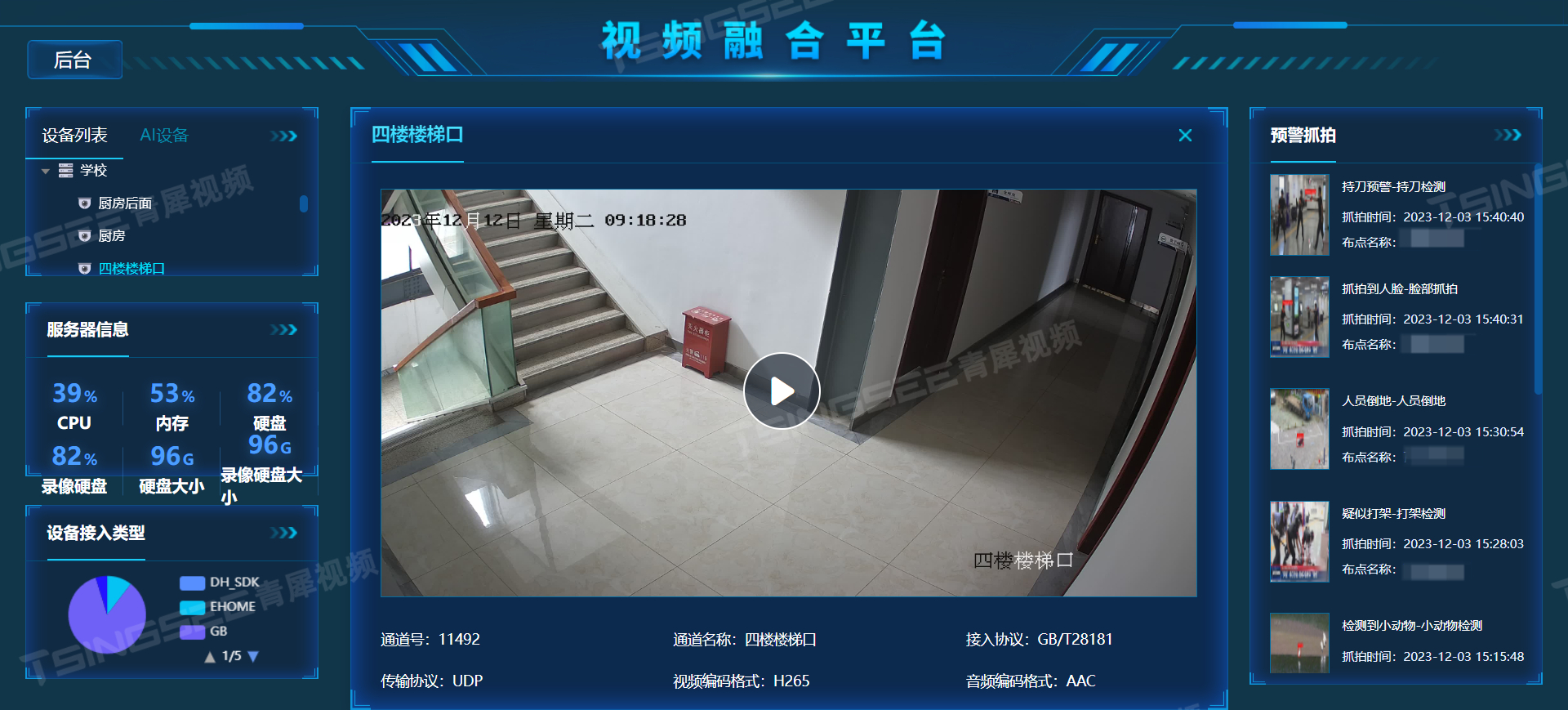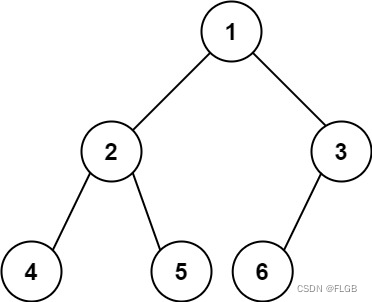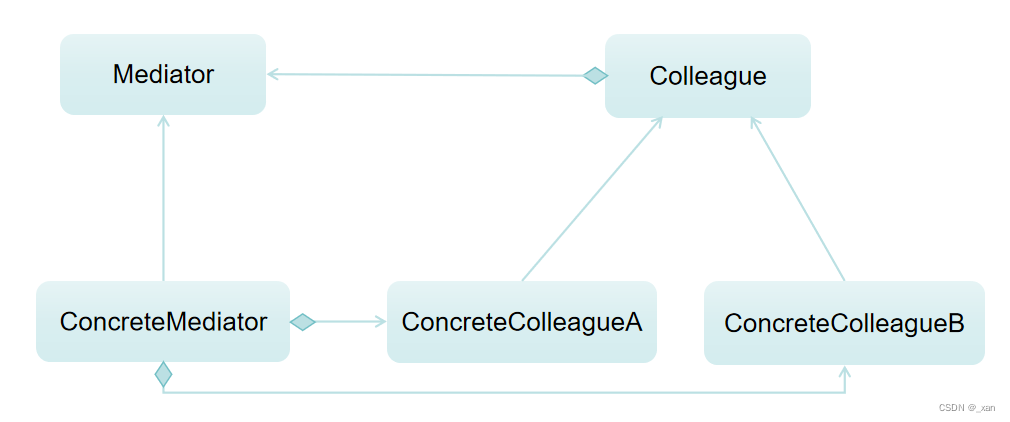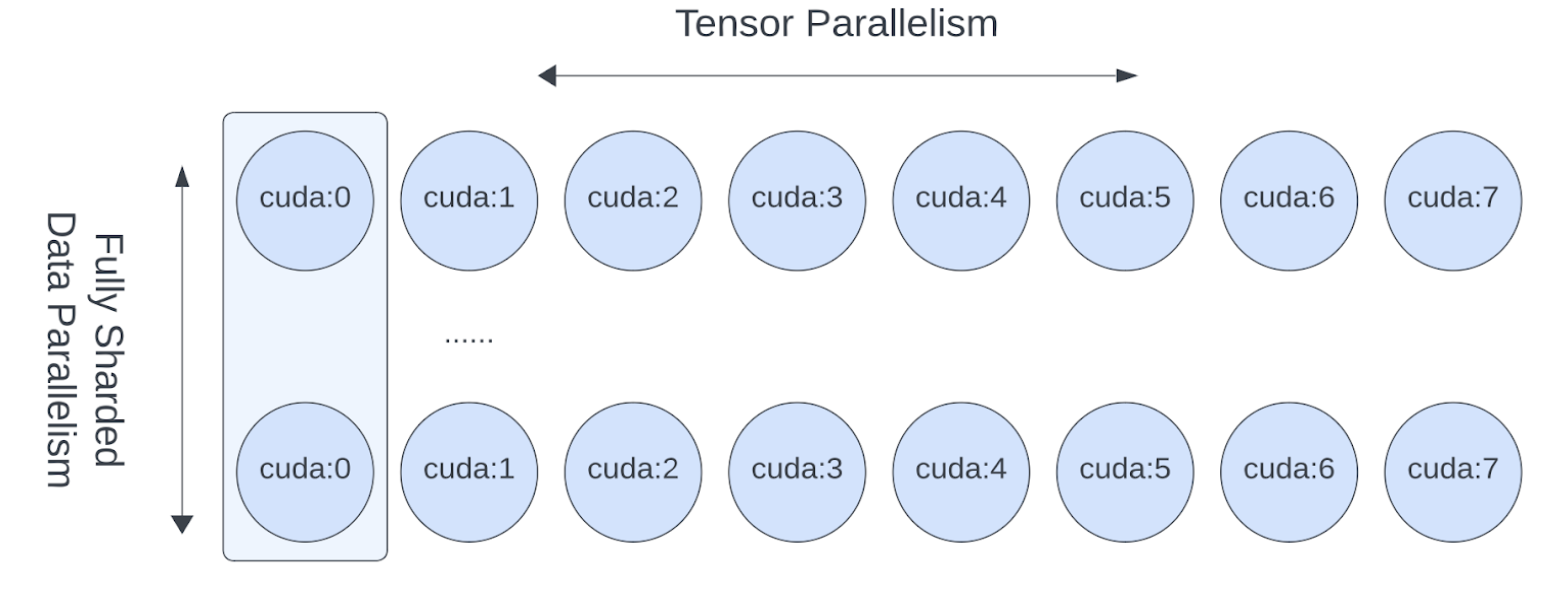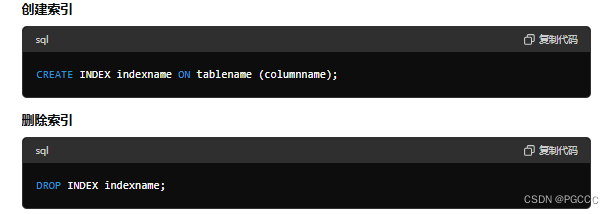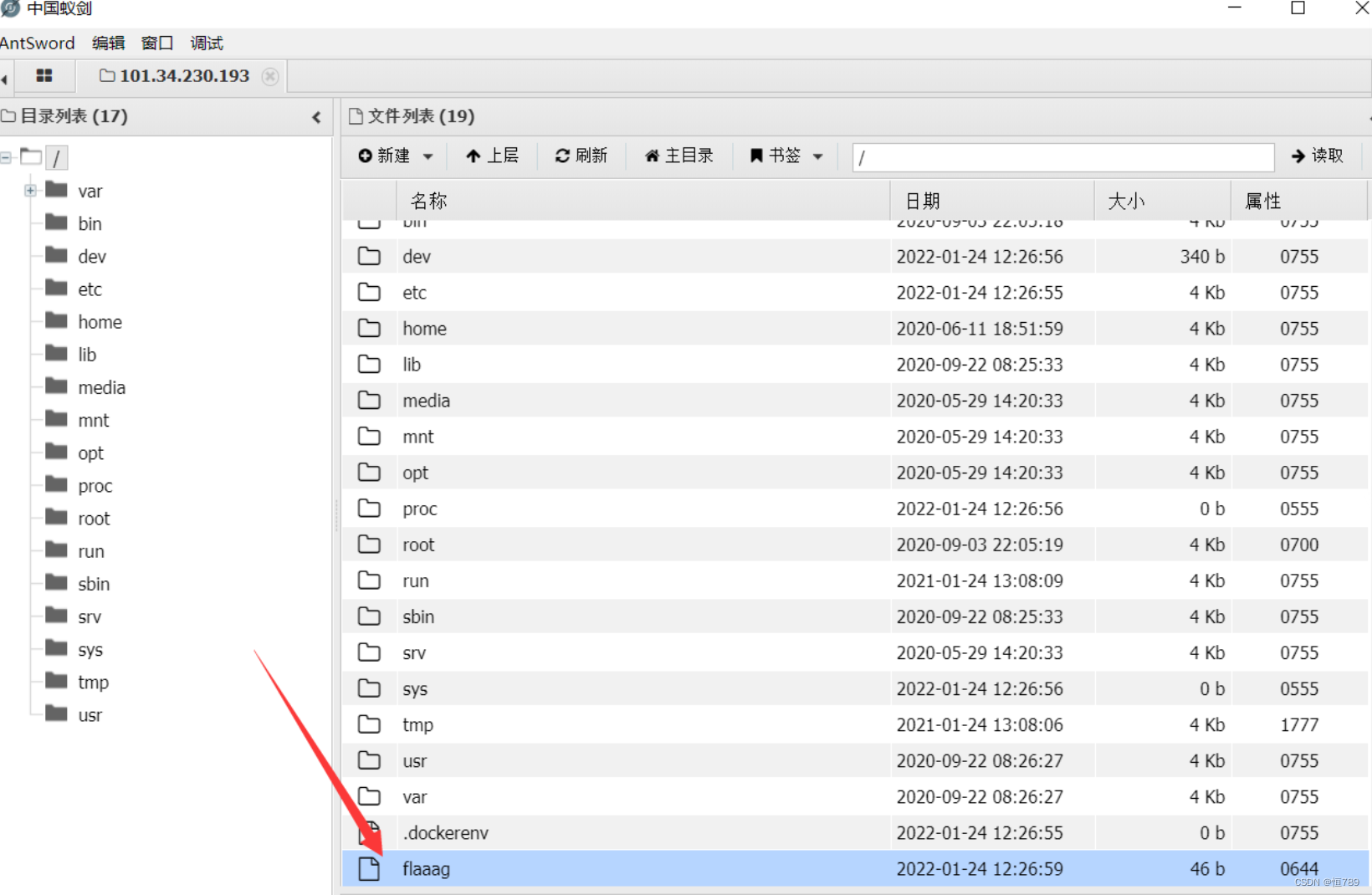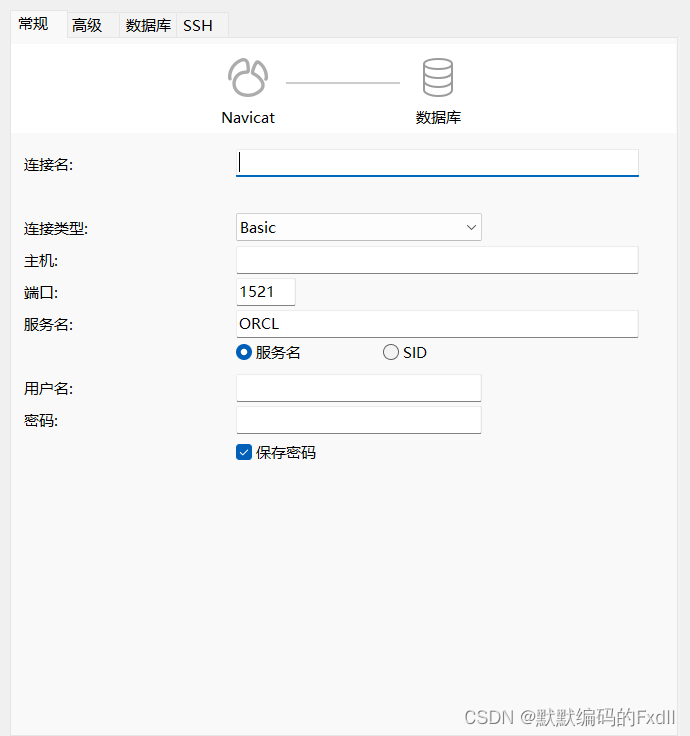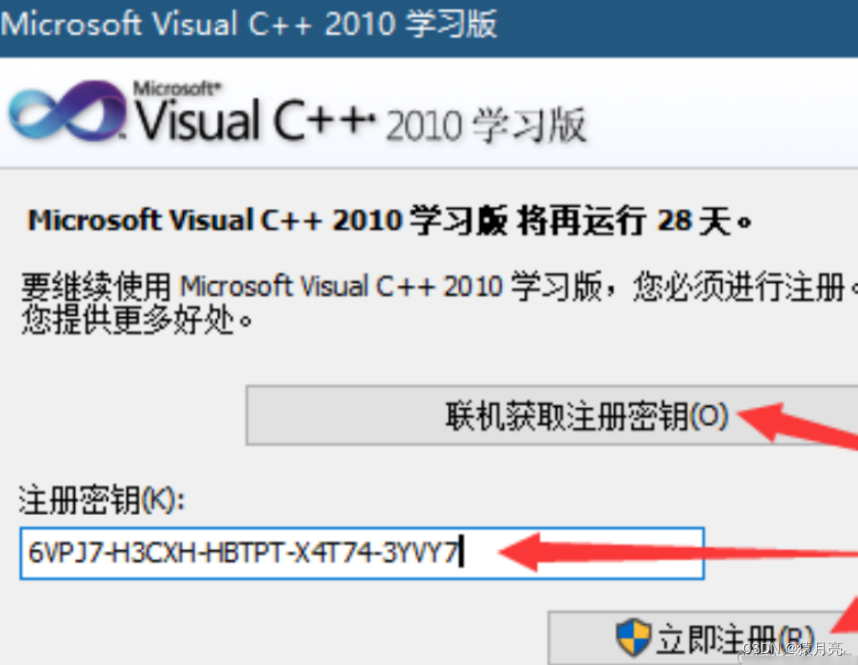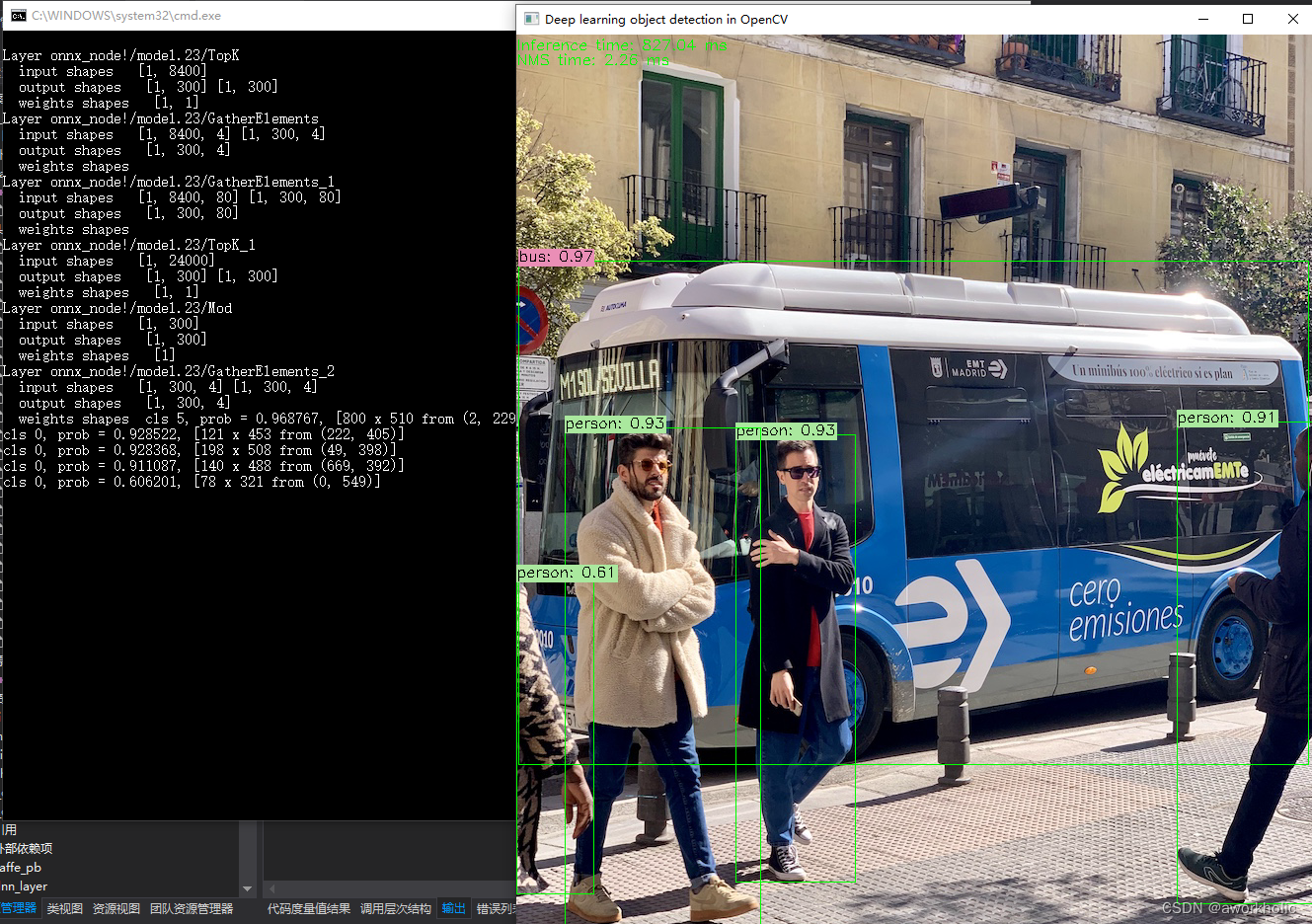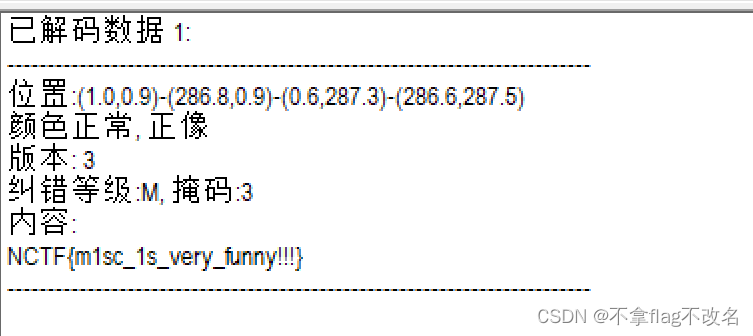前端开发
目的:开发一个平台(网站)
- 前端开发: HTML, CSS,JavaScript
- web框架:接收请求并进行处理
- MySQL数据库:存储相应的数据
1.快速开发网站
pip install flask
创建项目并导入flask框架,然后建立网址和函数的对应关系。
from flask import Flask
app = Flask(__name__)
# 创建网址 /show/info 和函数index的对应关系
@app.route('/show/info')
def index():
return "hello world"
if __name__ == '__main__':
app.run()
Flask框架为了让写标签方便,支持将字符串写入到文件里面。
from flask import Flask,render_template
app = Flask(__name__)
# 创建网址 /show/info 和函数index的对应关系
@app.route('/show/info')
def index():
# Flask内部会自动打开整个文件,并读取内容,将内容进行返回
# 我们需要把这些内容写在一个templates目录下面
return render_template("index.html")
if __name__ == '__main__':
app.run()
2.HTML(超文本传输语言)的结构及标签
2.1 HTML的结构
<!DOCTYPE html>
<html lang="en">
<head>
<meta charset="UTF-8"> # 指明文件的编码
<title>Title</title> # 显示在浏览器顶部的网站的名称
</head>
<body> # 在这个里面写主要内容
<h1>hello world!</h1> # 几级标题
</body>
</html>
2.2 标签
2.2.1 div和span
- div : 块级标签
- span: 自己多大占多大,行内标签
<div>内容</div>
<span>内容</span>
2.2.2 超链接
# 跳转到其他网站要写全
<a href="http://www.baidu.com">点击跳转</a>
# 跳转到自己网站
<a href="/login">点击跳转</a>
@app.route('/login')
def login():
return render_template("login.html")
2.2.3 图片
# 直接显示别人的图片地址
<img src="图片地址">
<img src="https://upen.caup.net/ai_pics_mj/202303/1678119808158776.jpg">
# 显示自己的图片
- 项目中创建static目录,图片放入其中
<img src="/static/1.png">
小结
- 块级标签
<h1></h1>
<div></div>
- 行内标签
<span></span>
<a></a>
<img>ddd
2.2.4 列表标签
<!-- 无序列表 -->
<ul>
<li>列表1</li>
<li>列表2</li>
</ul>
<!-- 有序列表 -->
<ol>
<li>列表1</li>
<li>列表2</li>
</ol>
2.2.4 表格
<table border="1px">
<thead>
<tr><td>ID</td><td>姓名</td><td>年龄</td></tr>
</thead>
<tbody>
<tr>
<td>01</td>
<td>桥川</td>
<td>20</td>
</tr>
</tbody>
</table>
2.2.5 input系列
<input type="text">
<input type="password">
<input type="file">
<input type="radio" name="man">男
<input type="radio" name="man">女
<input type="checkbox">篮球
<input type="checkbox">排球
<input type="checkbox">羽毛球
<input type="checkbox">台球
<input type="button" value="登录"> 普通的按钮
<input type="submit" value="提交"> 提交表单
2.2.6 下拉框
<select>
<option>上海</option>
<option>天津</option>
<option>西安</option>
</select>
2.2.7 多行文本
<textarea></textarea>
补充:
- 网络请求
-
- 在浏览器中输入URL,点击回车,然后进行访问。
- 浏览器向后端发送请求时
- GET请求 向后台传入的数据会拼接到URL上。
- Post请求 提交数据不在URL中而是在请求体中。
-
3.CSS样式
3.1 CSS应用方式
- 在标签上面
<input type="radio" name="gender" value="男" style="height: 30%">
-
在head标签中写style标签
<!DOCTYPE html> <html lang="en"> <head> <meta charset="UTF-8"> <title>Title</title> <style> <!-- 类选择器--> .h1{ color: aqua; } </style> </head> <body> <div> <h1 class="h1">用户登录</h1> <a>账号:<input type="text" name="account"></a><br> <a>密码:<input type="password" name="password"></a><br> <input type="submit" name="登录"> </div> </body> </html>-
写到css文件里面
<!DOCTYPE html> <html lang="en"> <head> <meta charset="UTF-8"> <title>Title</title> <link rel="stylesheet" href="common.css"> </head> <body> <div> <h1 class="h1">用户登录</h1> <a>账号:<input type="text" name="account"></a><br> <a>密码:<input type="password" name="password"></a><br> <input type="submit" name="登录"> </div> </body> </html>
-
3.2 选择器
- ID选择器(只能应用于一个标签)
```html
#h1{
}
<h1 id="h1">用户登录</h1>
```
- 类选择器(可以应用于多个标签)
```html
.h1{
}
<h1 class="h1">用户登录</h1>
```
- 标签选择器
```html
h1{
}
<h1>用户登录</h1>
```
- 属性选择器
```
input[type='text']{
border:1px solid red;
}
```
- 后代选择器
```css
.c1 li{
color:red;
}
```
3.3 样式
3.3.1 高度和宽度
.h1{
height:300px;
width:500px;
}
注意事项:
- 宽度:支持百分比。
- 行内标签:默认无效。
- 块级标签:默认有效。
3.3.2 块级和行内标签
通过css样式可以中合两者 display: inline-block
3.3.3 字体和颜色
.h1{
color: #00FF7F;
font-size:60px;
font-weight: 100;
font-family:Microsoft yahei;
}
3.3.4 浮动
<!DOCTYPE html>
<html lang="en">
<head>
<meta charset="UTF-8">
<title>Title</title>
</head>
<body>
<div>
<span>左边</span>
<span style="float:right">右边</span>
</div>
</body>
</html>
注意 : 把float用于div块级标签,会出现脱离文档流。
3.3.5 边距
/* 内边距*/
padding-top: 20px;
/*外边距*/
margin-top: 20px;
4.BootStrap
别人帮我们写好的CSS样式,如果使用需下载。
-
下载BootStrap
-
把BootStrap进行导入
4.1 导航
<!DOCTYPE html>
<html lang="en">
<head>
<meta charset="UTF-8">
<title>Title</title>
<link rel="stylesheet" href="../static/plugins/bootstrap-3.4.1/css/bootstrap.css">
</head>
<body>
<div class="navbar navbar-default" role="navigation">
<div class="container-fluid">
<!-- Brand and toggle get grouped for better mobile display -->
<div class="navbar-header">
<button type="button" class="navbar-toggle collapsed" data-toggle="collapse" data-target="#bs-example-navbar-collapse-1" aria-expanded="false">
<span class="sr-only">Toggle navigation</span>
<span class="icon-bar"></span>
<span class="icon-bar"></span>
<span class="icon-bar"></span>
</button>
<a class="navbar-brand" href="#">中国联通</a>
</div>
<!-- Collect the nav links, forms, and other content for toggling -->
<div class="collapse navbar-collapse" id="bs-example-navbar-collapse-1">
<ul class="nav navbar-nav">
<li class="active"><a href="#">Link <span class="sr-only">(current)</span></a></li>
<li><a href="#">广西</a></li>
<li><a href="#">上海</a></li>
<li><a href="#">四川</a></li>
</ul>
<form class="navbar-form navbar-left">
<div class="form-group">
<input type="text" class="form-control" placeholder="Search">
</div>
<button type="submit" class="btn btn-default">Submit</button>
</form>
<ul class="nav navbar-nav navbar-right">
<li><a href="#">登录</a></li>
<li><a href="#">注册</a></li>
<li class="dropdown">
<a href="#" class="dropdown-toggle" data-toggle="dropdown" role="button" aria-haspopup="true" aria-expanded="false">CPanMirai <span class="caret"></span></a>
<ul class="dropdown-menu">
<li><a href="#">Action</a></li>
<li><a href="#">Another action</a></li>
<li><a href="#">Something else here</a></li>
<li role="separator" class="divider"></li>
<li><a href="#">Separated link</a></li>
</ul>
</li>
</ul>
</div><!-- /.navbar-collapse -->
</div><!-- /.container-fluid -->
</div>
</body>
</html>
4.2 栅格系统
-
把整体划分为12格
-
分类
-
响应式,根据屏幕宽度不同
.col-lg- 1170px .col-md- 970px .col-sm- 750px -
非响应式
<div class="col-xs-6 col-sm-4">.col-xs-6 .col-sm-4</div> <div class="col-xs-6 col-sm-4">.col-xs-6 .col-sm-4</div> -
列偏移
<div class="row"> <div class="col-sm-offset-2 col-sm-6" style="background-color: #2aabd2">34245</div> </div>
-
<div class="row">
<div class="col-xs-12 col-sm-6 col-md-8" style="background-color: #2aabd2">.col-xs-12 .col-sm-6 .col-md-8</div>
<div class="col-xs-6 col-md-4">.col-xs-6 .col-md-4</div>
</div>
<div class="row">
<div class="col-xs-6 col-sm-4">.col-xs-6 .col-sm-4</div>
<div class="col-xs-6 col-sm-4">.col-xs-6 .col-sm-4</div>
<!-- Optional: clear the XS cols if their content doesn't match in height -->
<div class="clearfix visible-xs-block"></div>
<div class="col-xs-6 col-sm-4">.col-xs-6 .col-sm-4</div>
</div>
4.3 BootStrap依赖
BootStrap依赖JavaScript的类库,jQuery。
-
下载jQuery,在页面上应用于jQuery。
-
在页面上应用BootStrap的JavaScript类库。
<script src="../static/js/jquery-3.7.1.min.js"></script> <script src="../static/plugins/bootstrap-3.4.1/js/bootstrap.min.js"></script>
5.JavaScript(实现动态效果)
-
JavaScript,是一门编程语言。浏览器就是JavaScript的解释器。
-
DOM和BOM
相当于编程语言内置模块。 例如:python中re、random、time、json模块等。 -
jQuery
相当于编程语言中第三方模块。 例如:requests、openpyxl例如:
<!DOCTYPE html> <html lang="en"> <head> <meta charset="UTF-8"> <title>Title</title> <style> .menus{ width: 200px; border:1px solid red; } .menus .header{ background-color: gold; padding: 20px 10px; } </style> <script> function myFunc(){ confirm("是否继续?") } </script> </head> <body> <div class="menus"> <div class="header" onclick="myFunc()">大标题</div> <div class="item">内容</div> </div> </body> </html>
5.1 代码位置
<!DOCTYPE html>
<html lang="en">
<head>
<meta charset="UTF-8">
<title>Title</title>
<!-- 位置1-->
<script></script>
</head>
<body>
<div class="menus">
<div class="header" onclick="myFunc()">大标题</div>
<div class="item">内容</div>
</div>
<!-- 位置2-->
<script></script>
</body>
</html>
5.2 js代码的存在形式
- 当前的HTML中。
- 写在JavaScript文件进行导入即可。
5.3 变量
<script type="text/javascript">
var name="cp"
console.log(name);
</script>
5.4 字符串类型
// 声明
var name="cp";
var name=String("cp");
// 常见功能
var name="cp";
var v1=name.length;
var v2=name[0];
5.5 跑马灯
<!DOCTYPE html>
<html lang="en">
<head>
<meta charset="UTF-8">
<title>Title</title>
</head>
<body>
<span id="txt">如果您希望一遍又一遍地运行相同的代码,并且每次的值都不同,那么使用循环是很方便的。</span>
<script type="text/javascript">
function show() {
// 1. 找到标签,获取内容
var tag = document.getElementById("txt")
var dataString = tag.innerText;
// 2. 字符串拼接
var firstChar = dataString[0];
var otherString = dataString.substring(1, dataString.length)
var newText = otherString + firstChar
// 3.在html标签中更新内容
tag.innerText = newText
console.log(newText)
}
setInterval(show,1000)
</script>
</body>
</html>
5.6 数组
// 定义
var v1 = [1,2,3,4]
var v2 = Array([1,2,3,4]);
// 操作
var v1 = [1,2,3,4];
// 查
v1[0];
// 改
v1[0]=5;
// 增
v1.push(5); // 尾部追加 [1,2,3,4,5]
v1.unshift(5); // 前面追加 [5,1,2,3,4]
v1.splice(索引位置,0,元素);
v1.splice(1,0,5) // 尾部追加 [1,5,2,3,4]
// 删
v1.pop() // 尾部删除
v1.shift() // 头部删除
v1.splice(索引位置,1)
v1.splice(2,1) // 索引为2的元素删除 [1,2,4,5]
// 循环
var v1 = [1,2,3,4,5];
for(var idx in v1){
// idx = 0/1/2/3/4 data = v1[idx]
}
for(var i=0;i<v1.length;i++){
// idx = 0/1/2/3/4 data = v1[idx]
}
5.7 数组案例
<!DOCTYPE html>
<html lang="en">
<head>
<meta charset="UTF-8">
<title>Title</title>
</head>
<body>
<ul id="city"></ul>
<script type="text/javascript">
var cityList = ["北京","上海","深圳"]
for(var idx in cityList){
var text = cityList[idx];
// 创建li标签
var tag = document.createElement('li');
// 在li标签中写入内容
tag.innerText=text;
// 添加到city里面
var parentTag=document.getElementById("city");
parentTag.appendChild(tag)
}
</script>
</body>
</html>
5.8 对象(字典)
info = {
"name":“cp”,
"age":18
}
info = {
name:"cp",
age:18
}
// 查
info.age
info[age]
// 查、改
info.name = "xx"
info[name] = "xx"
// 删
delete info['age']
// 循环
for(var key in info){
// key = name/age data = info[key]
}
5.9 动态表格
<!DOCTYPE html>
<html lang="en">
<head>
<meta charset="UTF-8">
<title>Title</title>
</head>
<body>
<table border="1px">
<thead>
<tr>
<th>ID</th>
<th>姓名</th>
<th>年龄</th>
</tr>
</thead>
<tbody id="tbody"></tbody>
</table>
<script type="text/javascript">
var data = [{
"ID": 10000,
"name": "x0",
"age": 18
}, {
"ID": 10001,
"name": "x1",
"age": 18
}, {
"ID": 10002,
"name": "x2",
"age": 18
}]
for (var i = 0; i < data.length; i++) {
// 创建tr
var tagTr = document.createElement("tr");
for (var key in data[i]) {
var content = data[i][key];
var tag = document.createElement("td");
tag.innerText = content;
tagTr.appendChild(tag)
}
var tagTbody=document.getElementById('tbody')
tagTbody.appendChild(tagTr)
}
</script>
</body>
</html>
5.10 条件语句
if(){
}else{
}
5.11 函数
function func(){
...
}
5.12 DOM
DOM , 就是一个模块 , 模块可以对HTML页面中的标签进行操作。
// 根据ID获取标签
var tagTbody = document.getElementById('tbody')
// 获取标签中的文本
tagTbody.innerText
// 创建标签
var tagTbody = document.createElement("div");
// 向标签中增加内容
<!DOCTYPE html>
<html lang="en">
<head>
<meta charset="UTF-8">
<title>Title</title>
</head>
<body>
<ul id="city"></ul>
<script type="text/javascript">
var tag = document.getElementById("city")
var newTag = document.createElement("li");
newTag.innerText = "陕西";
tag.appendChild(newTag)
</script>
</body>
</html>
5.13 事件的绑定
<!DOCTYPE html>
<html lang="en">
<head>
<meta charset="UTF-8">
<title>Title</title>
</head>
<body>
<label>
请输入内容:
<input type="text" id="contentText">
<input type="button" value="点击增加" οnclick="addText()">
</label>
<ul id ="city"></ul>
<script>
function addText() {
// 创建li标签
var newTag=document.createElement("li")
// 获取输入框中的值赋值给新标签
newTag.innerText=document.getElementById("contentText").value
// 给标签增加孩子标签
document.getElementById("city").appendChild(newTag)
// 输入框内容清空
document.getElementById("contentText").value = ""
}
</script>
</body>
</html>
6.jQuery
jQuery是一个JavaScript第三方模块(第三方类库)。
例如:
<!DOCTYPE html>
<html lang="en">
<head>
<meta charset="UTF-8">
<title>Title</title>
<script src="../static/js/jquery-3.7.1.min.js"></script>
</head>
<body>
<h1 id="txt">中国加油!</h1>
<script type="text/javascript">
// 找到id=txt的标签并修改
$("#txt").text("hello world!");
</script>
</body>
</html>
6.1 寻找标签(直接寻找)
-
ID选择器
<h1 id = "txt"> 中国加油! </h1> $("#txt") -
样式选择器
<h1 class="c1">中国加油!</h1> $(".c1") -
标签选择器
<h1 class="c1">中国加油!</h1> $("h1") -
层级选择器
<h1 class="c1"> <div class="c2"> <span></span> </div> </h1> $(".c1 .c2 span") -
多选择器
<h1 class="c1"> <div class="c2"> <span></span> </div> </h1> $(".c1,.c2,span") -
属性选择器
<input type="text" name="n1"> <input type="text" name="n2"> <input type="text" name="n3"> $("input[name='n1']")
6.2 间接寻找
-
找到兄弟
<div> <div>篮球</div> <div id="c1">足球</div> <div>排球</div> </div> $("#c1").prev() // 找到上一个兄弟 $("#c1").next() // 找到下一个兄弟 $("#c1").siblings() // 找到除c1的所有兄弟 -
找父子
<div> <div> <div>篮球</div> <div id="c1">足球</div> <div>排球</div> </div> <div> <div>台球</div> <div>xx</div> <div>xx1</div> </div> </div> $("#c1").parent() // 找父亲 $("#c1").children() // 找所有的孩子
例子:下拉菜单
<!DOCTYPE html>
<html lang="en">
<head>
<meta charset="UTF-8">
<title>Title</title>
<script src="../static/js/jquery-3.7.1.min.js"></script>
<style>
.menus {
width: 200px;
height: 800px;
border: 1px solid red;
}
.menus .header {
background-color: gold;
padding: 10px 5px;
}
.menus .content a {
display: block;
margin-bottom: 10px;
border-bottom: 1px dotted #dddddd;
}
.hide {
display: none;
}
</style>
</head>
<body>
<div class="menus">
<div class="item">
<div class="header" onclick="test(this)">上海</div>
<div class="content hide">
<a>篮球</a>
<a>足球</a>
<a>排球</a>
</div>
</div>
<div class="item">
<div class="header" onclick="test(this)">上海2</div>
<div class="content hide">
<a>篮球2</a>
<a>足球2</a>
<a>排球2</a>
</div>
</div>
<div class="item">
<div class="header" onclick="test(this)">上海3</div>
<div class="content hide">
<a>篮球3</a>
<a>足球3</a>
<a>排球3</a>
</div>
</div>
</div>
<script>
function test(self) {
$(self).next().removeClass("hide")
$(self).parent().siblings().find(".content").addClass("hide")
}
</script>
</body>
</html>
6.3操作样式
- addClass
- removeClass
- hasClass
6.4 值的操作
<div id="d1">内容</div>
$("#d1").text() // 获取文本内容
$("#d1").text("内容1") // 设置文本内容
<input type="text" id="i2">
$("#i2").val() // 获取用户输入的值
$("#i2").val("hello world!") // 设置值
例子:动态增加数据
<!DOCTYPE html>
<html lang="en">
<head>
<meta charset="UTF-8">
<title>Title</title>
<script src="../static/js/jquery-3.7.1.min.js"></script>
<body>
<input type="text" id="txtUser" placeholder="用户名">
<input type="text" id="txtEmail" placeholder="邮箱">
<input type="button" value="提交" onclick="getInfo()">
<ul id="location">
</ul>
<script>
function getInfo() {
// 1. 获取用户名和邮箱
var userName = $("#txtUser").val()
var email = $("#txtEmail").val()
var dataString = userName+"\t"+email
// 2. 创建li标签,加入用户名和密码
var newLi = $("<li>").text(dataString)
$("#location").append(newLi)
}
</script>
</body>
</html>
6.5 事件
<ul>
<li>篮球</li>
<li>足球</li>
<li>排球</li>
</ul>
<script>
$("li").click(function(){
// 点击li标签时,自动执行这个函数
// $(this) 当前点击的是那个标签。
});
</script>
在JQuery中可以删除某个标签。
<div id="c1">
内容
</div>
$("#c1").remove()
<ul>
<li>篮球</li>
<li>足球</li>
<li>排球</li>
</ul>
<script>
$(function(){
// 当页面的框架加载完成之后,自动就执行。
$("li").click(function(){
$(this).remove();
});
});
</script>
例子:表格
<!DOCTYPE html>
<html lang="en">
<head>
<meta charset="UTF-8">
<title>Title</title>
<script src="../static/js/jquery-3.7.1.min.js"></script>
<body>
<table border="1px">
<thead>
<tr>
<th>ID</th>
<th>姓名</th>
<th>操作</th>
</tr>
</thead>
<tbody>
<tr>
<th>1001</th>
<th>cp</th>
<th><input type="button" value="删除" class="delete"></th>
</tr>
<tr>
<th>1002</th>
<th>cp2</th>
<th><input type="button" value="删除" class="delete"></th>
</tr>
<tr>
<th>1003</th>
<th>cp3</th>
<th><input type="button" value="删除" class="delete"></th>
</tr>
</tbody>
</table>
<script>
$(function () {
$(".delete").click(function () {
$(this).parent().parent().remove()
});
});
</script>
</body>
</html>
模板
<!DOCTYPE html>
<html lang="en">
<head>
<meta charset="UTF-8">
<title>Title</title>
<link rel="stylesheet" href="../static/plugins/bootstrap-3.4.1/css/bootstrap.css">
</head>
<body>
<script src="../static/js/jquery-3.7.1.min.js"></script>
<script src="../static/plugins/bootstrap-3.4.1/js/bootstrap.min.js"></script>
</body>
</html>
例子:添加数据页面
人员信息录入功能,用户信息:用户名、年龄、部门、入职时间
<!DOCTYPE html>
<html lang="en">
<head>
<meta charset="UTF-8">
<title>Title</title>
<link rel="stylesheet" href="../static/plugins/bootstrap-3.4.1/css/bootstrap.css">
</head>
<body>
<div class="container">
<form class="form-horizontal">
<div class="row clearfix">
<div class="col-xs-6">
<!--姓名-->
<div class="form-group">
<label class="col-sm-2 control-label">姓名</label>
<div class="col-sm-10">
<input type="text" class="form-control" id="inputEmail3" placeholder="姓名">
</div>
</div>
</div>
<div class="col-xs-6">
<!--年龄-->
<div class="form-group">
<label class="col-sm-2 control-label">年龄</label>
<div class="col-sm-10">
<input type="text" class="form-control" id="inputAge" placeholder="年龄">
</div>
</div>
</div>
</div>
<div class="row clearfix" >
<div class="col-xs-6">
<!--部门-->
<div class="form-group">
<label class="col-sm-2 control-label">部门</label>
<div class="col-sm-10">
<!-- <input type="text" class="form-control" id="inputDepartments" placeholder="年龄">-->
<select class="form-control">
<option>IT部门</option>
<option>销售部门</option>
<option>运营部门</option>
</select>
</div>
</div>
</div>
<div class="col-xs-6">
<div class="form-group">
<label class="col-sm-2 control-label">入职日期</label>
<div class="col-sm-10">
<input type="date" class="form-control" id="inputTime" placeholder="入职日期">
</div>
</div>
</div>
</div>
<div class="form-group">
<div class="col-sm-offset-2 col-sm-10">
<button type="submit" class="btn btn-primary">提交</button>
</div>
</div>
</form>
</form>
</div>
<script src="../static/js/jquery-3.7.1.min.js"></script>
<script src="../static/plugins/bootstrap-3.4.1/js/bootstrap.min.js"></script>
<script></script>
</body>
</html>
7.python操作MySql
用python代码连接MySQL并发送指令。
pip install pymysql
python代码
import pymysql
# 1. 连接mysql数据库
conn=pymysql.connect(host="127.0.0.1",port=3306,user="root",passwd="123456",charset="utf8",db="unicom")
cursor=conn.cursor(cursor=pymysql.cursors.DictCursor)
# 2. 发送指令
cursor.execute("insert into admin(username,password,mobile) values('admin','123456','18729749445')")
conn.commit()
# 3. 关闭
conn.close()
cursor.close()
7. mysql中文乱码
SHOW FULL COLUMNS FROM admin;
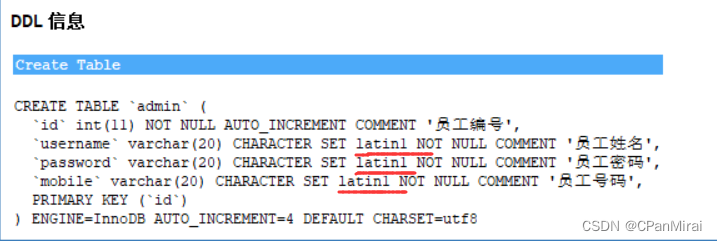
CREATE DATABASE unicom DEFAULT CHARSET utf8 COLLATE utf8_general_ci;
CREATE TABLE admin(
id INT NOT NULL AUTO_INCREMENT PRIMARY KEY,
username VARCHAR(16) NOT NULL,
PASSWORD VARCHAR(64) NOT NULL,
mobile CHAR(11) NOT NULL
)DEFAULT CHARSET=utf8;
python代码
import pymysql
# 1. 连接mysql数据库
conn = pymysql.connect(host="127.0.0.1", port=3306, user="root", passwd="123456", charset="utf8", db="unicom")
cursor = conn.cursor(cursor=pymysql.cursors.DictCursor)
# 2. 发送指令(不要用字符串格式化去做sql的拼接,安全隐患SQL注入)
# sql="insert into admin(username,password,mobile) values(%s,%s,%s)"
# cursor.execute(sql,['admin1','123456','234234'])
sql = "insert into admin(username,password,mobile) values(%(n1)s,%(n2)s,%(n3)s)"
cursor.execute(sql, {"n1": "陈破案", "n2": "123456", "n3": "123456"})
conn.commit()
# 3. 关闭
conn.close()
cursor.close()
查询数据
import pymysql
# 1. 连接mysql数据库
conn = pymysql.connect(host="127.0.0.1", port=3306, user="root", passwd="123456", charset="utf8", db="unicom")
cursor = conn.cursor(cursor=pymysql.cursors.DictCursor)
# 2. 发送指令
cursor.execute("select * from admin")
data_list = cursor.fetchall()
for row_dict in data_list:
print(row_dict)
# 3. 关闭
conn.close()
cursor.close()
删除
import pymysql
# 1. 连接mysql数据库
conn = pymysql.connect(host="127.0.0.1", port=3306, user="root", passwd="123456", charset="utf8", db="unicom")
cursor = conn.cursor(cursor=pymysql.cursors.DictCursor)
# 2. 发送指令
sql = "delete from admin where id=%s"
cursor.execute(sql,[2,])
conn.commit()
# 3. 关闭
conn.close()
cursor.close()
修改数据
import pymysql
# 1. 连接mysql数据库
conn = pymysql.connect(host="127.0.0.1", port=3306, user="root", passwd="123456", charset="utf8", db="unicom")
cursor = conn.cursor(cursor=pymysql.cursors.DictCursor)
# 2. 发送指令
sql = "update admin set mobile=%s where id=%s"
cursor.execute(sql,["1898943",1,])
conn.commit()
# 3. 关闭
conn.close()
cursor.close()
强调:
- 在进行新增、删除、修改时,要记得commit,而在查询的时候,不需要commit,执行fetchall / fetchone
结合flask框架
from flask import Flask, render_template, request
import pymysql
app = Flask(__name__)
@app.route('/add/user', methods=['GET', 'POST'])
def add_user():
if request.method == 'GET':
return render_template("add_user.html")
else:
user = request.form.get('user')
pwd = request.form.get('pwd')
mobile = request.form.get('mobile')
conn = pymysql.connect(host="127.0.0.1", port=3306, user="root", passwd="123456", charset="utf8", db="unicom")
cursor = conn.cursor(cursor=pymysql.cursors.DictCursor)
sql = "insert into admin(username,password,mobile) values(%s,%s,%s)"
cursor.execute(sql, [user, pwd, mobile])
res = conn.commit()
print(res)
# 3. 关闭
conn.close()
cursor.close()
return "success"
@app.route('/show/user')
def show_user():
conn = pymysql.connect(host="127.0.0.1", port=3306, user="root", passwd="123456", charset="utf8", db="unicom")
cursor = conn.cursor(cursor=pymysql.cursors.DictCursor)
sql = "select * from admin"
cursor.execute(sql)
dataList = cursor.fetchall()
# 3. 关闭
conn.close()
cursor.close()
print(dataList)
return render_template("show_user.html",dataList=dataList)
if __name__ == '__main__':
app.run()
add_user.html
<!DOCTYPE html>
<html lang="en">
<head>
<meta charset="UTF-8">
<title>Title</title>
</head>
<body>
<h1>添加用户</h1>
<form method="post" action="/add/user">
<input type="text" name="user" placeholder="用户名">
<input type="text" name="pwd" placeholder="密码">
<input type="text" name="mobile" placeholder="手机号">
<input type="submit" value="提交">
</form>
</body>
</html>
show_user.html
<!DOCTYPE html>
<html lang="en">
<head>
<meta charset="UTF-8">
<title>Title</title>
</head>
<body>
<h1>用户列表</h1>
<table border="1px">
<thead>
<tr>
<th>ID</th>
<th>姓名</th>
<th>密码</th>
<th>手机号</th>
</tr>
</thead>
<tbody>
{% for item in dataList %}
<tr>
<td>{{ item.id }}</td>
<td>{{ item.username }}</td>
<td>{{ item.password }}</td>
<td>{{ item.mobile }}</td>
</tr>
{% endfor %}
</tbody>
</table>
</body>
</html>
template模板的作用
- 找到html页面,读取所有的内容。
- 找到内容中”特殊的占位符“,将数据替换。
- 将替换完成的字符串返回用户的浏览器。
8.安装Django
通过pip安装,win+R打开命令窗口,输入cmd , 在控制台输入以下命令:
pip install django
# 如果有多个python版本的话,需要指定,以3.12为例
pip3.12 install django
遇到问题如下:
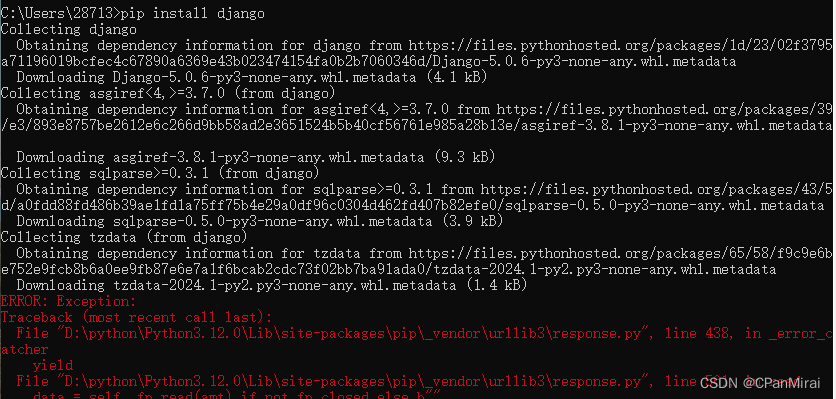
解决:切换网络,可能网速问题,导致下载失败。
成功:
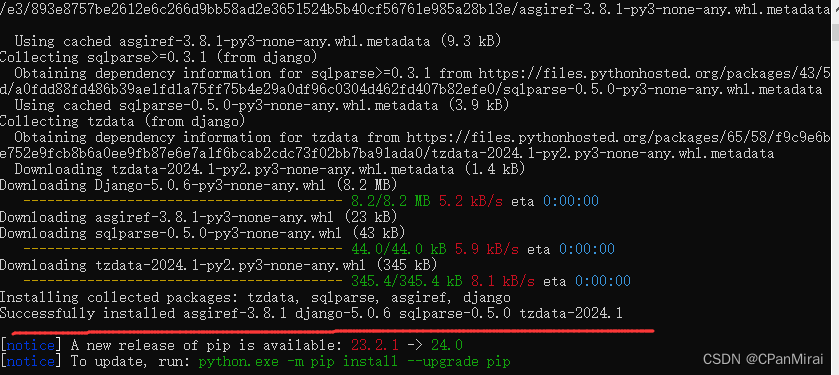
为了保险起见,可以再看看python的文件夹,是否在scripts里面出现django-admin.exe以及Lib中出现django。
D:\python\Python3.12.0
- python.exe
-Scripts
-pip.exe
-django-admin.exe # 工具,用于创建django项目中的文件和文件夹
- Lib
-内置模块
-site-packages
- openpyxl
- python-docx
- flask
- django # 框架的源码
9.创建项目(两种方式)
django中项目会有一些默认的文件和文件夹。
9.1 终端创建
-
win+R,输入cmd,打开终端。
-
cd 目录(切换到项目的目录)
cd /d F:\python\python_Web -
执行命令创建项目
“D:\python\Python3.12.0\Scripts\django-admin.exe” startproject 项目名称# 如果D:\python\Python3.12.0\Scripts 已加入环境系统环境变量 django-admin startproject 项目名称 -
查看是否创建成功

9.2 pycharm里面创建
-
点击文件,创建项目

-
选择Django项目,修改项目的位置、名称、python版本。
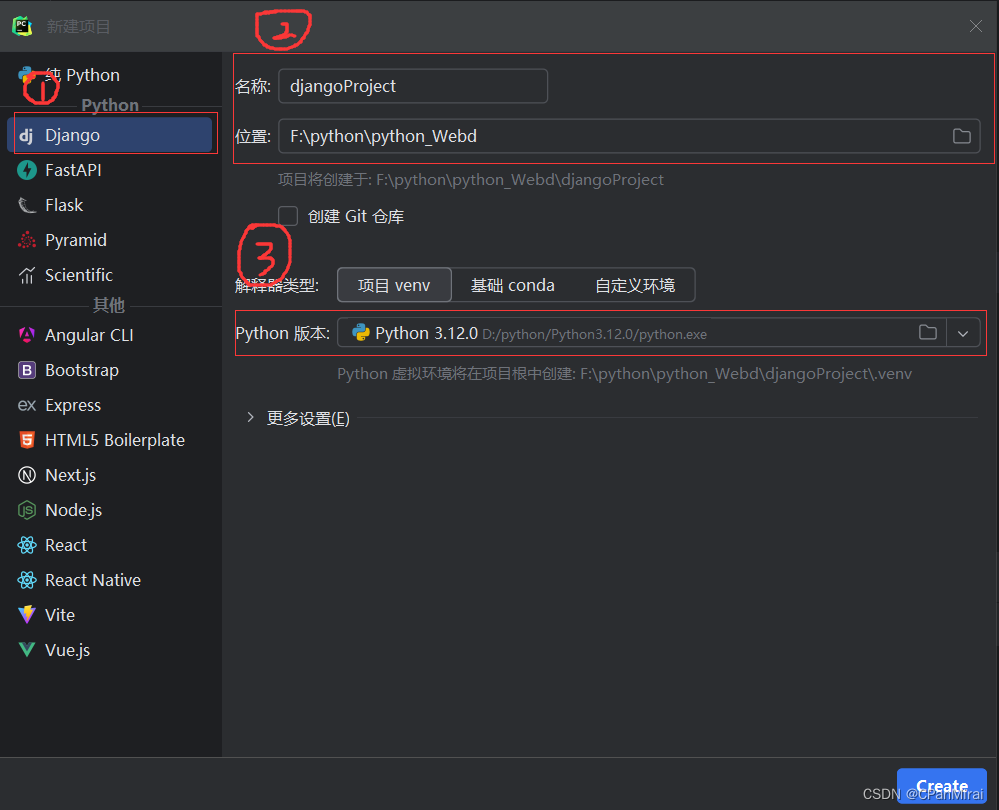
两者对比:
-
命令行:创建的标准项目。
-
pycharm:会在默认基础上面加入了点东西。
-
创建了一个templates目录(删除) 。
-
settings.py里面找到Dir,把里面的内容删除。

-
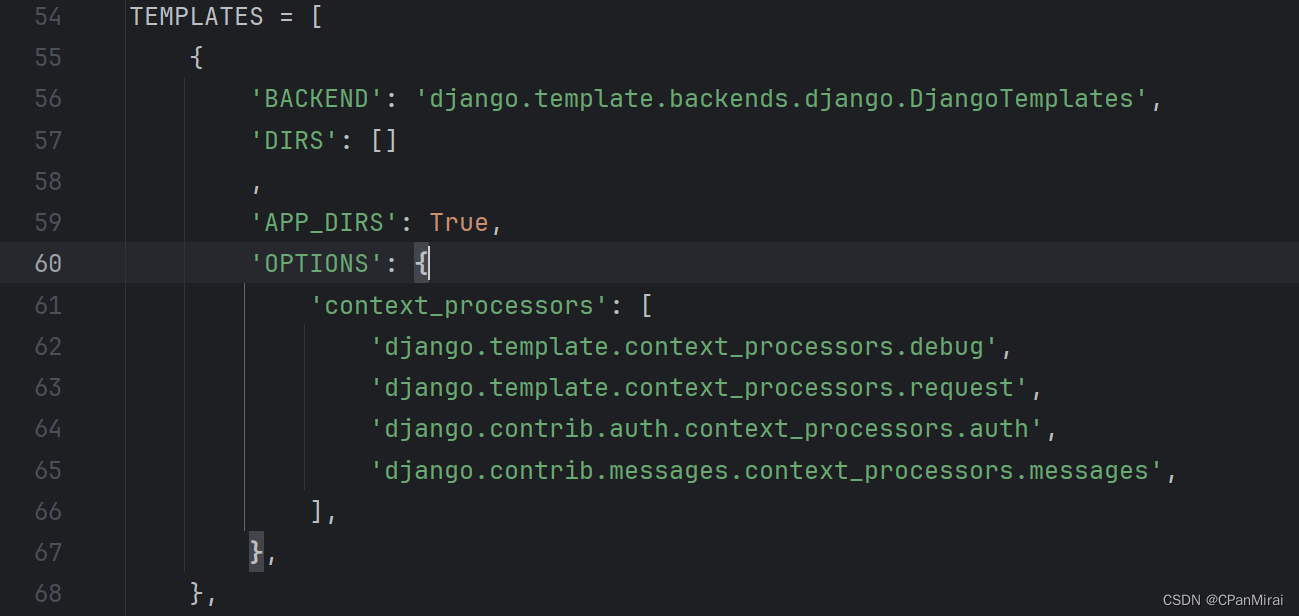
默认项目的文件介绍:
django_Basic
- manage.py # 项目的管理,启动项目,创建app,数据管理 不要动,但会经常用
- django_Basic
- __init__.py
- asgi.py # 异步接收网络请求 不要动
- settings.py # 项目的配置文件 常常修改
- urls.py # url和函数的对应关系 常常修改
- wsgi.py # 同步接收网络请求 不要动
10.创建APP
- 项目
- app,用户管理 # 表结构、函数、html模板、css
- app,订单管理 # 表结构、函数、html模板、css
- app,后台管理 # 表结构、函数、html模板、css
- app,API # 表结构、函数、html模板、css
...
注意:我们目前开发,用不到多app,一般情况下,项目创建1个app即可。

- app01
- __init__.py
- admin.py # 固定,不用动 django默认提供了admin后台管理,但是基本很少使用
- apps.py # 固定,不用动 app启动类
- migrations # 固定,不用动 数据库字段变更记录(自动生成)
- __init__.py
- models.py # 对数据库操作
- tests.py # 进行单元测试
- views.py # 视图函数(重要)
- manage.py
- django_Basic
- __init__.py
- asgi.py
- settings.py
- urls.py
- wsgi.py
11.快速上手
11.1 第一个页面
确保app已注册
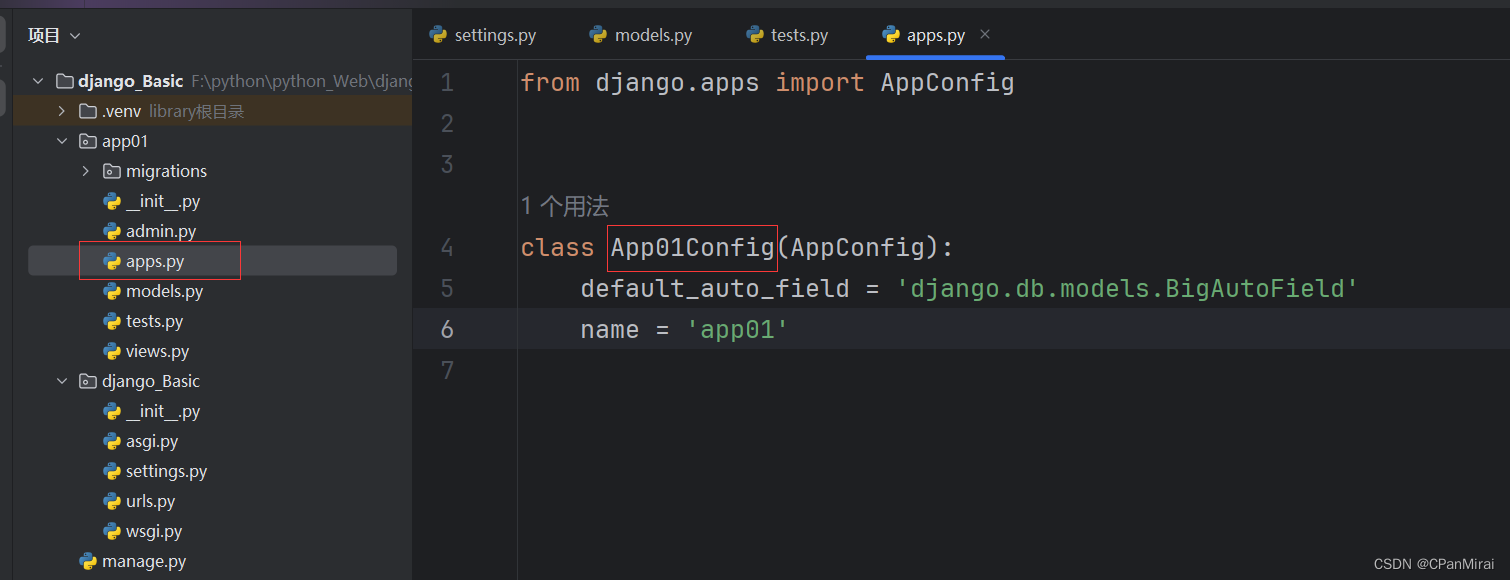
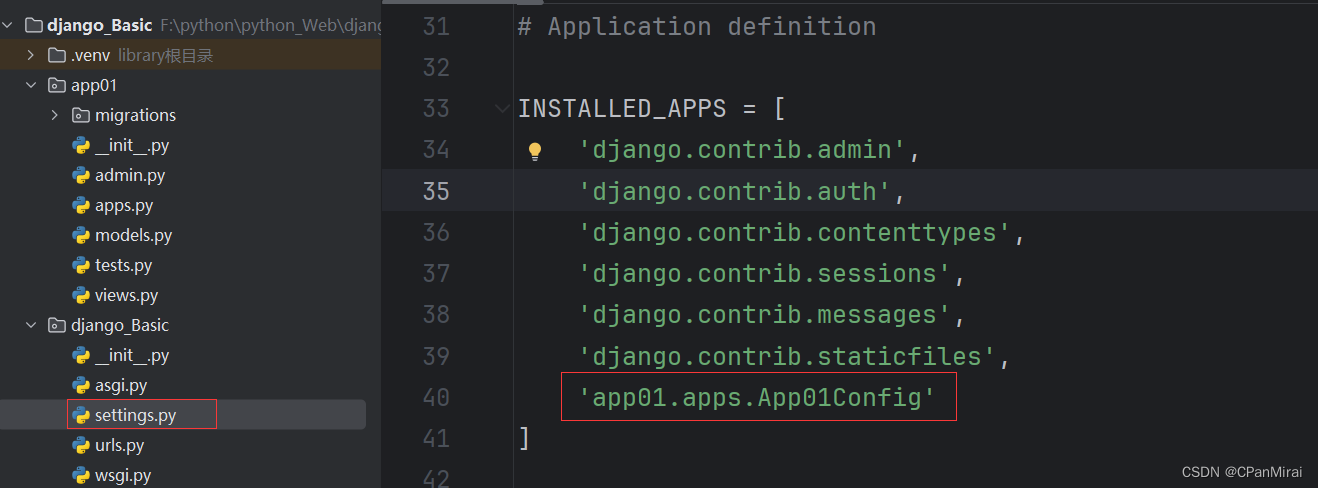
编写URL和视图函数对应关系(urls.py)

编写试图函数(views.py)

启动Django项目
- 命令行启动
python manage.py runserver
-
pycharm启动
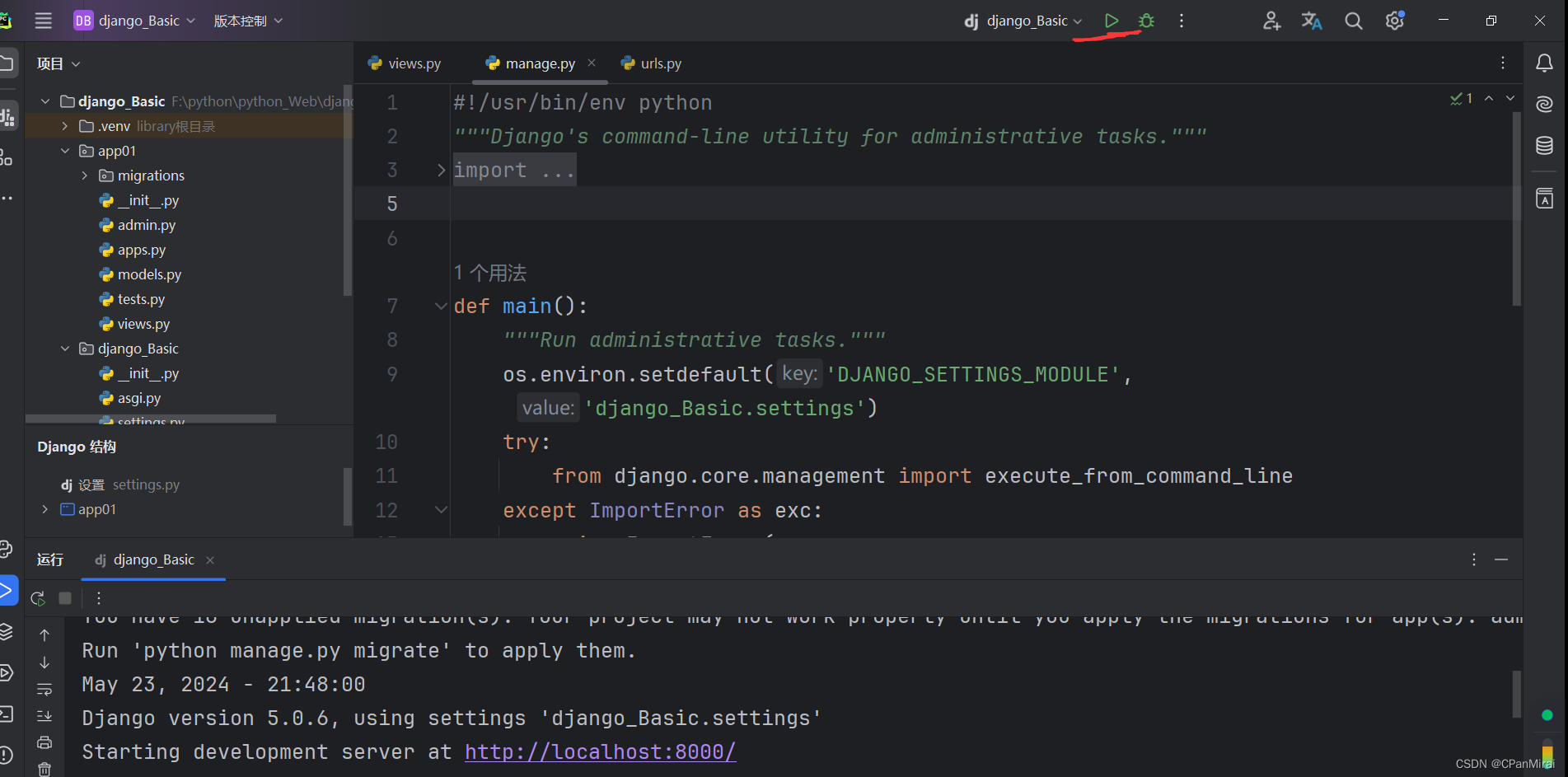
以后都是重复这些操作。
11.2 templates模板
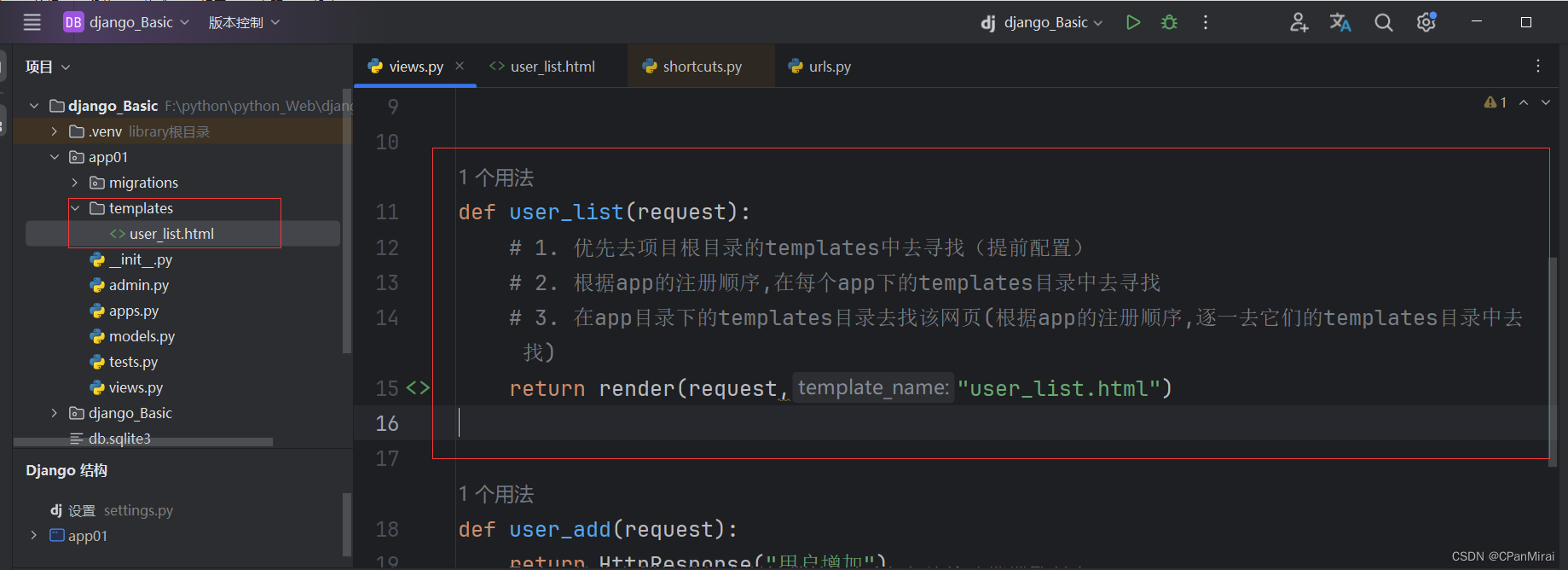
11.3静态文件
在开发过程中一般将:图片、css、js当作静态文件处理。
{#这样写方便项目上线#}
{% load static %}
<!DOCTYPE html>
<html lang="en">
<head>
<meta charset="UTF-8">
<title>Title</title>
<link rel="stylesheet" href="{% static 'plugins/bootstrap-3.4.1/css/bootstrap.css' %}">
</head>
<body>
<script src="{% static 'js/jquery-3.7.1.min.js' %}"></script>
<script src="{% static 'plugins/bootstrap-3.4.1/js/bootstrap.min.js' %}"></script>
</body>
</html>
12.模板语法
本质上:在HTML中写一些占位符,由数据对这些占位符进行替换和处理。
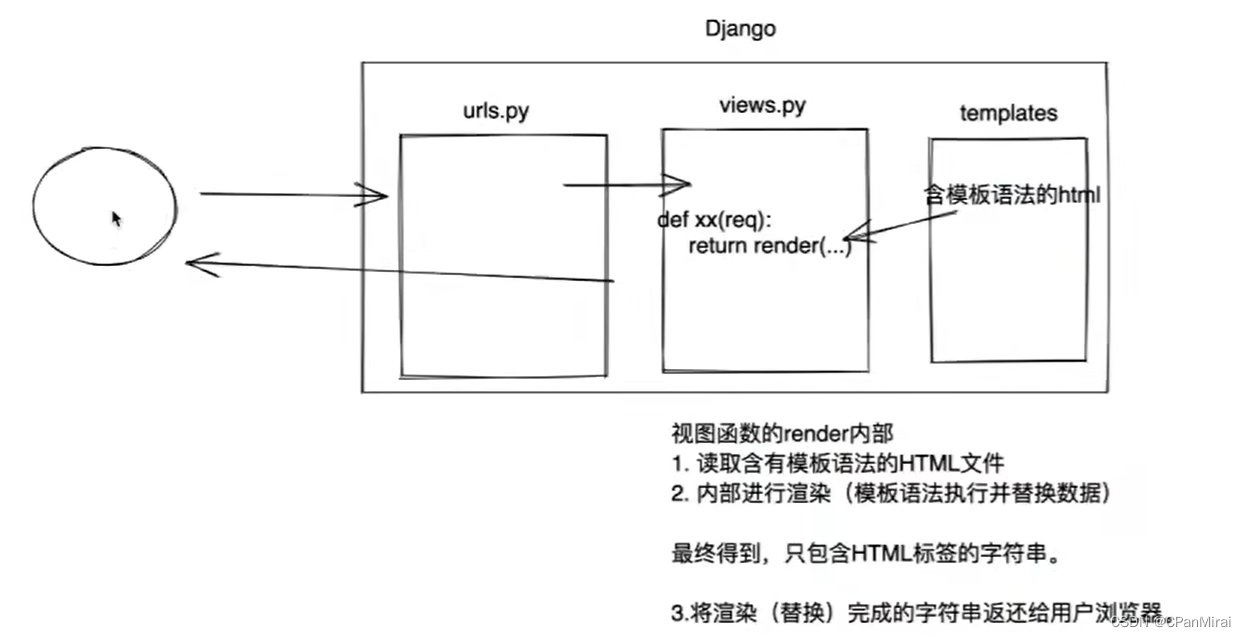
{#这样写方便项目上线#}
{% load static %}
<!DOCTYPE html>
<html lang="en">
<head>
<meta charset="UTF-8">
<title>Title</title>
<link rel="stylesheet" href="{% static 'plugins/bootstrap-3.4.1/css/bootstrap.css' %}">
</head>
<body>
<div>{{ n1 }}</div>
<div>{{ n2.0 }}</div>
<div>
{% for item in n2 %}
<span>{{ item }}</span><br>
{% endfor %}
</div>
<div>
<a>{{ n3.name }}</a>
<a>{{ n3.salary }}</a>
<a>{{ n3.role }}</a>
</div>
<div>
{% for k,v in n3.items %}
<li>{{ k }}={{ v }}</li>
{% endfor %}
</div>
<div>
{% for item in n4 %}
<div>{{ item.name }}</div>
<div>{{ item.salary }}</div>
<div>{{ item.role }}</div>
{% endfor %}
</div>
{% if n1 == "xx" %}
<h1>true</h1>
{% else %}
<h1>false</h1>
{% endif %}
<script src="{% static 'js/jquery-3.7.1.min.js' %}"></script>
<script src="{% static 'plugins/bootstrap-3.4.1/js/bootstrap.min.js' %}"></script>
</body>
</html>
def tpl(request):
name = "xxx"
roles = [1, 2, 3]
user_info = {"name": "xxx", "salary": 100, "role": "debug"}
data_list = [{"name": "xxx1", "salary": 100, "role": "debug"}, {"name": "xxx2", "salary": 100, "role": "debug"},
{"name": "xxx3", "salary": 100, "role": "debug"}]
return render(request, 'tpl.html', {"n1": name, "n2": roles, "n3": user_info, "n4": data_list})
13.请求和响应
关于重定向:
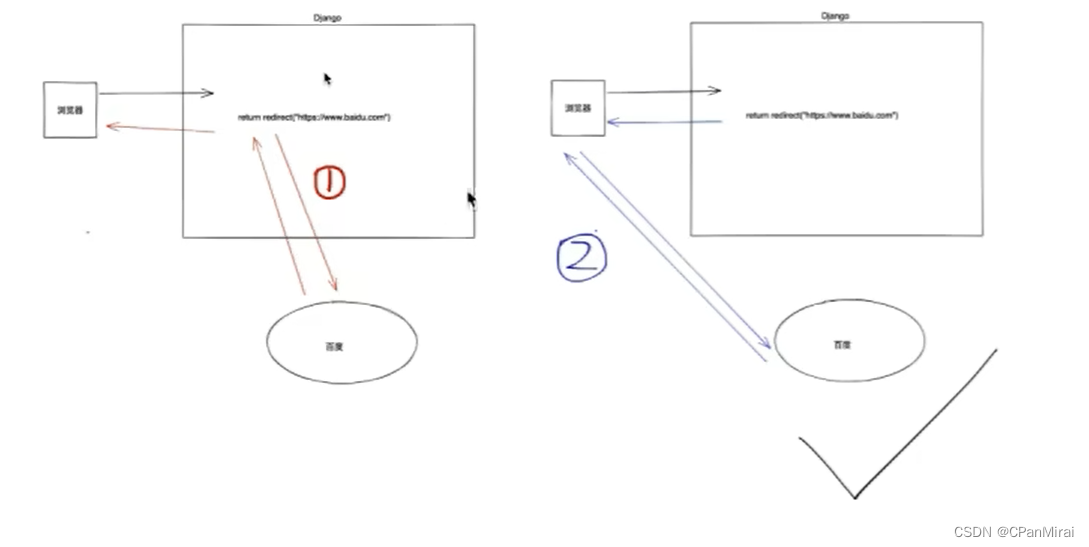
# urls.py
path('something/', views.something)
# views.py
def something(request):
# request是一个对象,封装了用户发送过来的所有请求相关数据
# 1. 获取请求方式 GET/POST
print(request.method)
# 2. 在URL上传递值
print(request.GET)
# 3. 在请求体中提交数据
print(request.post)
# 4. [响应] HttpResponse("返回内容") 内容字符串内容返回给请求者。
# return HttpResponse("返回内容")
# 5. [响应] 读取HTML的内容 + 渲染(替换) -> 字符串,返回给用户浏览器。
# return render(request,'news.html',{'title':"中国"})
# 6. [响应] 让浏览器重定向
return redirect('https://www.baidu.com')
登录案例:
def login(request):
if request.method == "POST":
username = request.POST['user']
password = request.POST['pwd']
if username=="xxxx" and password=="<PASSWORD>":
return HttpResponse("登录成功!")
else:
return render(request, 'login.html',{'error_msg':"用户名或密码错误"})
else:
return render(request, 'login.html')
<!DOCTYPE html>
<html lang="en">
<head>
<meta charset="UTF-8">
<title>Title</title>
<link rel="stylesheet" href="../static/plugins/bootstrap-3.4.1/css/bootstrap.css">
<style>
body {
width: 100%;
height: 100%;
}
.center {
width: 400px;
height: 300px;
margin-left: auto;
margin-right: auto;
margin-top: 10%;
border: 1px solid #dddddd;
padding: 20px 40px;
border-radius: 10px;
box-shadow: 2px 2px 20px #aaa;
}
</style>
<body>
<div class="center">
<h2 style="text-align: center ">用户登录</h2>
<form method="post" action="/login/">
{% csrf_token %}
<div class="form-group">
<label>账号</label>
<input type="text" name="user" class="form-control" id="exampleInputEmail1" placeholder="账号">
</div>
<div class="form-group">
<label>密码</label>
<input type="password" name="pwd" class="form-control" id="exampleInputPassword1" placeholder="密码">
</div>
<input type="submit" value="登录" class="btn-info"
style="margin-left: 40%;width: 100px;height: 40px;border-radius: 5px">
<span>{{ error_msg }}</span>
</form>
</div>
</body>
</html>
14.数据库操作
- MySQL数据库 + pymysql
import pymysql
# 1. 连接mysql数据库
conn = pymysql.connect(host="127.0.0.1", port=3306, user="root", passwd="123456", charset="utf8", db="unicom")
cursor = conn.cursor(cursor=pymysql.cursors.DictCursor)
# 2. 发送指令
cursor.execute("select * from admin")
data_list = cursor.fetchall()
for row_dict in data_list:
print(row_dict)
# 3. 关闭
conn.close()
cursor.close()
- Django使用内部的ORM框架 。
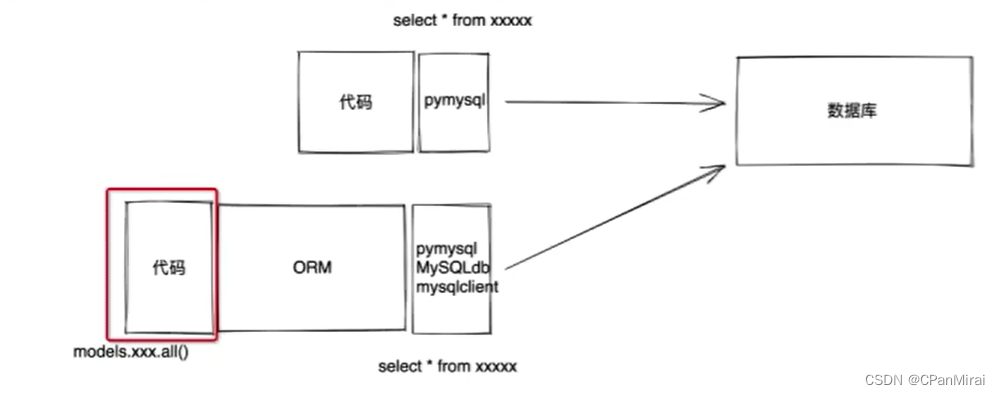
14.1安装第三方模块
pip install mysqlclient
14.2 ORM
ORM可以做两件事:
- 创建、修改、删除数据库中的表
- 操作表中的数据
14.3 Django连接数据库
在settings.py文件中进行配置和修改。
DATABASES = {
'default': {
'ENGINE': 'django.db.backends.mysql',
'NAME': 'unicom',
'USER': 'root',
'PASSWORD': '123456',
'HOST': 'localhost',
'PORT': 3306
}
}
models.py文件配置
from django.db import models
class UserInfo(models.Model):
name = models.CharField(max_length=30)
pwd = models.CharField(max_length=64)
age = models.IntegerField()
"""
create table app01_userinfo(
id integer primary key auto_increment,
name varchar(30),
password varchar(64),
age int
)
"""
Django命令生成数据库表
python manage.py makemigrations
python manage.py migrate
在表中新增列时,由于已存在列中可能已有数据,所以新增列必须要指定新增列对应的数据:
-
手动输入一个值。
-
设置默认值。
age = models.IntegerField(default=2) -
允许为空。
data = models.IntegerField(null = True,blank = True)
ORM实现增删改查
def orm(request):
# 增加数据
# models.UserInfo.objects.create(name="陈34", pwd="123456")
# 删除数据
# models.UserInfo.objects.filter(id=2).delete()
# 获取数据
# data_list = models.UserInfo.objects.all()
# for obj in data_list:
# print(obj.id, obj.name, obj.pwd, obj.age)
# 修改数据
models.UserInfo.objects.filter(id=3).update(age=100)
return HttpResponse("success")
15.模板的继承
# layout.html
{% load static %}
<!DOCTYPE html>
<html lang="en">
<head>
<meta charset="UTF-8">
<title>Title</title>
<link rel="stylesheet" href="{% static 'plugins/bootstrap-3.4.1/css/bootstrap.min.css' %}">
</head>
<body>
<!-- 导航栏 -->
<nav class="navbar navbar-default container">
<div class="container-fluid">
<div class="navbar-header">
<button type="button" class="navbar-toggle collapsed" data-toggle="collapse"
data-target="#bs-example-navbar-collapse-1" aria-expanded="false">
<span class="sr-only">Toggle navigation</span>
<span class="icon-bar"></span>
<span class="icon-bar"></span>
<span class="icon-bar"></span>
</button>
<a class="navbar-brand" href="#">用户管理系统</a>
</div>
<div class="collapse navbar-collapse" id="bs-example-navbar-collapse-1">
<ul class="nav navbar-nav">
<li><a href="/depart/list/">部门管理</a></li>
<li><a href="#">Link</a></li>
</ul>
<ul class="nav navbar-nav navbar-right">
<li><a href="#">登录</a></li>
<li class="dropdown">
<a href="#" class="dropdown-toggle" data-toggle="dropdown" role="button" aria-haspopup="true"
aria-expanded="false">CPanMirai <span class="caret"></span></a>
<ul class="dropdown-menu">
<li><a href="#">个人资料</a></li>
<li><a href="#">我的信息</a></li>
<li role="separator" class="divider"></li>
<li><a href="#">注销</a></li>
</ul>
</li>
</ul>
</div>
</div>
</nav>
<div>
{% block content %}
{% endblock %}
</div>
<script src="{% static 'js/jquery-3.7.1.min.js' %}"></script>
<script src="{% static 'plugins/bootstrap-3.4.1/js/bootstrap.min.js' %}"></script>
</body>
</html>
# index.html
{% extends 'layout.html' %}
{% block content %}
内容
{% endblock %}
16.Django组件
例子
def user_add(request):
"""添加用户"""
if request.method == "GET":
content = {
"gender_choice": models.UserInfo.gender_choices,
"depart_list": models.Department.objects.all()
}
return render(request, "user_add.html", context=content)
Django组件
-
Form组件
class MyForm(Form): user = forms.ModelChoiceField(widget=forms.Input) pwd = forms.ModelChoiceField(widget=forms.Input) email = forms.ModelChoiceField(widget=forms.Input) def user_add(request): """添加用户""" if request.method == "GET": return render(request, "user_add.html")<form method="post"> {{ form.user }} {{ form.pwd }} {{ form.email }} </form><form method="post"> {{% for field in form %}} {{ field }} {{ % endfor %}} </form> -
ModelForm组件
class MyForm(Form): class Meta: model = UserInfo fieleds = ["user","pwd","email"]
- Link
<ul class="nav navbar-nav navbar-right"> <li><a href="#">登录</a></li> <li class="dropdown"> <a href="#" class="dropdown-toggle" data-toggle="dropdown" role="button" aria-haspopup="true" aria-expanded="false">CPanMirai <span class="caret"></span></a> <ul class="dropdown-menu"> <li><a href="#">个人资料</a></li> <li><a href="#">我的信息</a></li> <li role="separator" class="divider"></li> <li><a href="#">注销</a></li> </ul> </li> </ul> </div> </div>{% block content %}```{% endblock %}# index.html {% extends 'layout.html' %} {% block content %} 内容 {% endblock %}16.Django组件
例子
def user_add(request): """添加用户""" if request.method == "GET": content = { "gender_choice": models.UserInfo.gender_choices, "depart_list": models.Department.objects.all() } return render(request, "user_add.html", context=content)Django组件
-
Form组件
class MyForm(Form): user = forms.ModelChoiceField(widget=forms.Input) pwd = forms.ModelChoiceField(widget=forms.Input) email = forms.ModelChoiceField(widget=forms.Input) def user_add(request): """添加用户""" if request.method == "GET": return render(request, "user_add.html")<form method="post"> {{ form.user }} {{ form.pwd }} {{ form.email }} </form><form method="post"> {{% for field in form %}} {{ field }} {{ % endfor %}} </form> -
ModelForm组件
class MyForm(Form): class Meta: model = UserInfo fieleds = ["user","pwd","email"]
-
